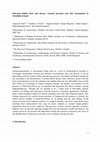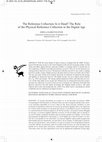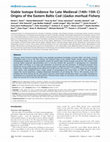Papers by S. Hamilton-Dyer
2.1. Introduction: chronology building in the Maltese islands 2.1.1. Malta and megalithismus 2.1.... more 2.1. Introduction: chronology building in the Maltese islands 2.1.1. Malta and megalithismus 2.1.2. Malta and the Mediterranean: the development of absolute chronologies 2.2. Methodology 2.2.1. Sources of data 2.2.2. AMS radiocarbon dating 2.2.3. Bayesian phase modelling 2.2.4. Density modelling 2.3. Results 2.3.1. Early Neolithic Għar Dalam and Skorba phases 2.3.2. Fifth millennium hiatus 2.3.3. Żebbuġ phase 2.3.4. Mġarr / transitional Ġgantija phase 2.3.5. Ġgantija phase 2.3.6. Saflieni phase 2.3.7. Tarxien phase 2.3.8. Thermi phase vi 2.3.9. Tarxien Cemetery phase 2.3.10. Borġ in-Nadur phase 2.3.11. Preferred model summary 2.3.12. Kernel density model 2.3.13. Comparison with other regions 2.4. Non-prehistoric dates 2.5. Discussion 2.6. Conclusion Chapter

Journal of Archaeological Science, 2018
Archaeoparasitology is increasingly being used as a tool in archaeological research to investigat... more Archaeoparasitology is increasingly being used as a tool in archaeological research to investigate relationships between past humans, environments, diets and disease. It can be particularly useful in contexts where parasite eggs preserve, but human and faunal remains do not, including in the identification of disease and/or dietary items otherwise absent from the local archaeological record. We analyzed soil samples from the Late Mesolithic layers of the lake island site of Derragh in County Longford, Ireland. All samples were positive for the presence of Diphyllobothrium sp., an intestinal fish tapeworm that infects humans, causing diphyllobothriasis. Though fish are thought to be a staple food in Mesolithic Ireland, evidence for fishing and subsistence from this period is extremely fragmentary. Similarly, there is little available evidence for disease, primarily due to the lack of human remains. This finding represents the earliest known presence of human-derived parasites in Ireland, the earliest known finding of Diphyllobothrium sp. in Europe and the only finding of the tapeworm from hunter-gatherer contexts. It suggests parasitic infections, particularly those resulting from undercooked food, may be more common in ancient hunter-gatherer populations than previously suspected. The presence of these zoonotic parasites at huntergatherer sites can provide important insight into local environments, health and disease, and culinary practices. In locations like Mesolithic Ireland, the presence of parasites may assist in the identification of subsistence activities, such as fishing, and specific prey.
Antiquity
The 'Portus Project' investigates the social and economic contexts of the maritime port of Imperi... more The 'Portus Project' investigates the social and economic contexts of the maritime port of Imperial Rome. This article presents the results of analysis of plant, animal and human remains from the site, and evaluates their significance for the reconstruction of the diets and geographic origins of its inhabitants between the second and sixth centuries AD. Integrating this evidence with other material from the recent excavations, including ceramic data, the authors identify clear diachronic shifts in imported foods and diet that relate to the commercial and political changes following the breakdown of Roman control of the Mediterranean.
Antiquity, 2019
The 'Portus Project' investigates the social and economic contexts of the maritime port of Imperi... more The 'Portus Project' investigates the social and economic contexts of the maritime port of Imperial Rome. This article presents the results of analysis of plant, animal and human remains from the site, and evaluates their significance for the reconstruction of the diets and geographic origins of its inhabitants between the second and sixth centuries AD. Integrating this evidence with other material from the recent excavations, including ceramic data, the authors identify clear diachronic shifts in imported foods and diet that relate to the commercial and political changes following the breakdown of Roman control of the Mediterranean.

Archaeofauna International Journal of Archaeozoology, 2013
With the recent launch of online resources resulting from the AHRC Archaeological Fish Resource p... more With the recent launch of online resources resulting from the AHRC Archaeological Fish Resource project in the United Kingdom (UK) and the increasing number of other online and offline digital reference materials available, it is perhaps timely to consider the relative importance of digital versus physical reference resources. There are several questions concerning location and ease of access. The physical collection may not be easy to get to, perhaps housed in another country. Digital resources should in theory be more accessible, but are they? The size and scope of both can be limited: physically, by problems of acquisition and storage; and digitally, by format and selection. The digital resource can never supply certain information, e.g., DNA and isotopes. The storage and dissemination of these and other data are, however, exactly what online access can provide. With pressure on existing fish stocks and on museum space for collections, we need to work out ways to integrate our collections, both with other physical collections and with rapidly developing and changing digital resources. This paper explores these issues and incorporates the results of an online survey concerning the current availability and use of physical and digital resources.
Royal Society Open Science, 2015
A comparison of ancient DNA (single-nucleotide polymorphisms) and carbon and nitrogen stable isot... more A comparison of ancient DNA (single-nucleotide polymorphisms) and carbon and nitrogen stable isotope evidence suggests that stored cod provisions recovered from the wreck of the Tudor warship Mary Rose, which sank in the Solent, southern England, in 1545, had been caught in northern and transatlantic waters such as the northern North Sea and the fishing grounds of Iceland and Newfoundland. This discovery, underpinned by control data from archaeological samples of cod bones from potential source regions, illuminates the role of naval provisioning in the early development of extensive sea fisheries, with their long-term economic and ecological impacts.
Proceedings of the Prehistoric Society, 1997
Small-scale rescue excavations during the course of pipeline construction have revealed a single ... more Small-scale rescue excavations during the course of pipeline construction have revealed a single Middle Bronze Age round-house, ring-ditch, and pits on a lowland site in the upper Severn valley with associated radiocarbon determinations which suggest a date within the range 1400–1170 cal BC. Associated finds include a large assemblage of charred naked barley and plain and decorated vessels of cordoned, bucket, and barrel urn traditions, together with a quern and a rubbing stone. The round-house, the first building of this date to be found in central Wales, can be paralleled with ones of similar date elsewhere, especially in southern England.
Medieval Archaeology, 1993
Advanced plough erosion prompted rescue excavation at the moated site of Castle of Wardhouse in 1... more Advanced plough erosion prompted rescue excavation at the moated site of Castle of Wardhouse in 1988. An integrated programme of work involving aerial photography, field survey, remote sensing, palynological analysis and excavation enabled interpretation of the complex development of the site in its historic environment (beyond this, palynology indicates human intervention in the environs since at least 5000 BP). The

PLoS ONE, 2011
Although recent historical ecology studies have extended quantitative knowledge of eastern Baltic... more Although recent historical ecology studies have extended quantitative knowledge of eastern Baltic cod (Gadus morhua) exploitation back as far as the 16th century, the historical origin of the modern fishery remains obscure. Widespread archaeological evidence for cod consumption around the eastern Baltic littoral emerges around the 13th century, three centuries before systematic documentation, but it is not clear whether this represents (1) development of a substantial eastern Baltic cod fishery, or (2) large-scale importation of preserved cod from elsewhere. To distinguish between these hypotheses we use stable carbon and nitrogen isotope analysis to determine likely catch regions of 74 cod vertebrae and cleithra from 19 Baltic archaeological sites dated from the 8th to the 16th centuries. d 13 C and d 15 N signatures for six possible catch regions were established using a larger sample of archaeological cod cranial bones (n = 249). The data strongly support the second hypothesis, revealing widespread importation of cod during the 13th to 14th centuries, most of it probably from Arctic Norway. By the 15th century, however, eastern Baltic cod dominate within our sample, indicating the development of a substantial late medieval fishery. Potential human impact on cod stocks in the eastern Baltic must thus be taken into account for at least the last 600 years.
REPORTS An Early Iron Age Occupation Site, a Roman Shrine and Other Prehistoric Activity at Coxwe... more REPORTS An Early Iron Age Occupation Site, a Roman Shrine and Other Prehistoric Activity at Coxwell Road, Faringdon By Steven DG Weaver and Steve Ford with contributions by Paul Cannon, Adam Croney, Sheila Hamilton-Dyer, David Richards, Mark Robinson, Chris ...
Journal of Roman Archaeology, 1998
International Journal of Osteoarchaeology, 1997
Journal of Archaeological Science, 2008
Acta Zoologica Cracoviensia, 2002
HAMILTON-DYER S. 2002. The Bird Resources of Medieval Novgorod, Russia. In: Proceedings of the 4t... more HAMILTON-DYER S. 2002. The Bird Resources of Medieval Novgorod, Russia. In: Proceedings of the 4th Meeting of the ICAZ Bird Working Group Kraków, Poland, 11-15 September, 2001. Acta zoologica cracoviensia, 45(special issue): 99-107. Abstract. This paper summarises ...
Documenta Archaeobiologiae, 2006
Uploads
Papers by S. Hamilton-Dyer
provisioning: ancient DNA and stable isotope analyses of stored cod from the wreck of the Mary Rose, AD 1545. Royal Society Open Science 2: 150199. http://dx.doi.org/10.1098/rsos.150199
A comparison of ancient DNA (single-nucleotide poly-
morphisms) and carbon and nitrogen stable isotope evidence
suggests that stored cod provisions recovered from the wreck
of the Tudor warship Mary Rose, which sank in the Solent,
southern England, in 1545, had been caught in northern and
transatlantic waters such as the northern North Sea and the
fishing grounds of Iceland and Newfoundland. This discovery,
underpinned by control data from archaeological samples of
cod bones from potential source regions, illuminates the role
of naval provisioning in the early development of extensive sea
fisheries, with their long-term economic and ecological impacts.